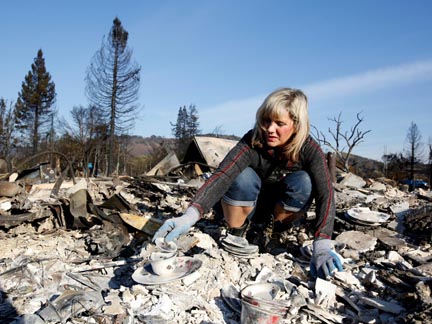

SANTA ROSA, CA: Even before fire wiped out the home she rented for 17 years, Suzanne Finzell had thought about leaving this city on the edge of the San Francisco Bay Area because of rising prices. A spike in housing and other living costs had driven her friends to Nevada and Oregon.
Now Finzell wonders if that will be her fate too, as the wildfires that charred California wine country send thousands of people who lost their homes scrambling for new places to live in one of the nation’s tightest and most expensive housing markets.
Before the fires, the rental vacancy rate was a mere 1 percent in Santa Rosa and 3 percent in surrounding Sonoma County. Then the city lost an estimated 5 percent of its housing stock to the flames.
“We had a housing crisis before the fires,” Mayor Chris Coursey said Wednesday. “It’s magnitude’s worse now.”
Meanwhile, authorities reported more progress against the flames. The deputy chief of the California Department of Forestry and Fire Protection said crews had stopped the movement of all fires.
Firefighters were helped by cooler weather and the lack of wind.
The fires that swept through parts of seven counties were the deadliest and most destructive series of blazes in California history. At least 42 people died and 6,000 homes were lost.
The flames were especially devastating in Sonoma and Napa counties on the northern edge of the Bay Area – a region that has seen housing prices skyrocket in recent years amid a technology industry boom. In San Francisco, an average one-bedroom apartment rents for more than $3,000 a month, and the median home price is about $1.5 million.
Cities such as Santa Rosa, about 50 miles north of San Francisco, have offered more affordable housing for people willing to endure a longer commute. But that may not be the case anymore.
The 62-year-old Finzell, who has lived in Santa Rosa since she was 3, said the housing situation means her generation “heads into retirement with no chance of living in the places we grew up.”
Housing for displaced families is “going to be a really big challenge,” said Ana Lugo, president of the North Bay Organizing Project, an organization that advocates for affordable housing in Sonoma County.
Lugo said government officials are still focused on putting out the fires and “repopulating” evacuated neighborhoods. But she said the affordable housing issue will need to be addressed, including preventing price gouging.
Elsewhere in the aftermath, a spokesman for the Sonoma County Sheriff’s Office said he did not expect the county’s death toll to go much higher. It stood at 23.
“The number of dead people we’re finding has really slowed down,” Sgt. Spencer Crum said, and many people listed as missing have been found safe.
About half of the 50 missing person reports are for homeless people. Crum does not believe they perished in fires because they did not live in the hardest-hit areas.
An estimated 100,000 people were evacuated at the height of the fires, and about 22,000 remain under evacuation.
Many homeowners who lost houses or condos said insurance would cover the cost of temporary housing and rebuilding. But those who rented faced greater uncertainty.
Yvette Escutia, 28, lost the four-bedroom, three-bath home she rented in Santa Rosa’s Coffey Park neighborhood for $1,750 a month.
The rent was already lower than that of a neighbor, who was paying $2,800 for a similar unit, so she expected a steep rent hike. She and her 2-year-old son, parents and other family members were at a friend’s house, where she planned to stay “until they kick us out,” she said.
Affordable housing advocates are concerned that many residents, especially the working poor, will have difficulty remaining in the region.
Escutia vowed to stay in Santa Rosa. “It’s going to be very expensive, but we have our jobs here and we were born here,” she said.
Tenants Together, a renters’ rights group in San Francisco, warned that landlords could not raise rents by more than 10 percent under a state of emergency declared by Gov. Jerry Brown in Napa and Sonoma counties. The group encouraged tenants who face steeper rent hikes to contact local prosecutors.
Finzell, a nursing assistant, was trying to get permission to put a trailer on the property that she rented. But she may have to look for another rental home, an option that she knows would be unaffordable. She lamented that the area had turned into a destination for tourists and the “ultra-rich.”
“There has to be a balance,” she said. “There has to be a way where those who loved and built this land for generations can retain and stay here if they choose to.”-AP






